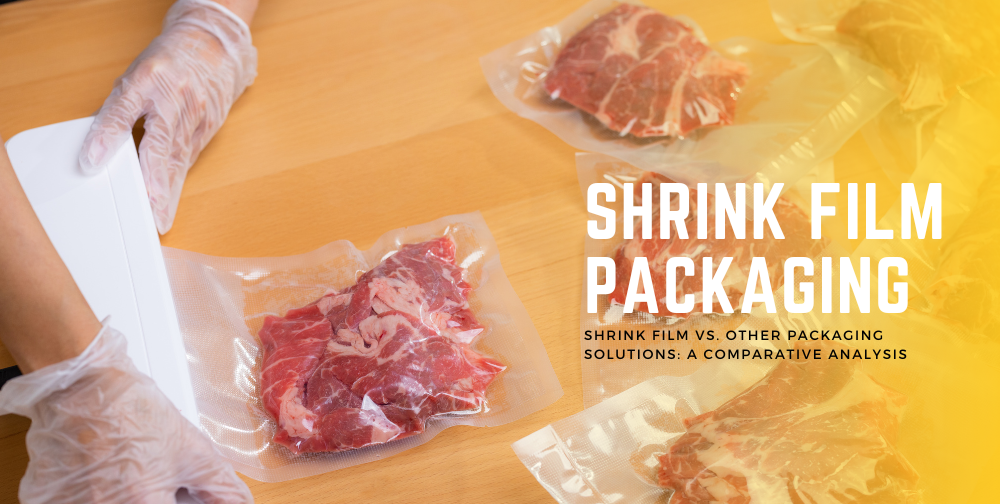Shrink Film vs. Other Packaging Solutions: A Comparative Analysis – TechBullion

Packaging plays a crucial role in the supply chain, influencing product distribution’s safety, efficiency, and cost-effectiveness. The choice of packaging material can significantly impact the integrity and appeal of products, as well as the environmental footprint of a business. Among the myriad packaging options available, shrink film, stretch film, bubble wrap, and cardboard stand out due to their widespread use and unique properties. This article delves into a comparative analysis of these popular packaging solutions, examining their advantages and disadvantages and providing recommendations tailored to various packaging needs and industries.
Shrink film, known for its ability to tightly conform to the shape of the packaged item when heat is applied, offers robust protection against external elements. Stretch film, another widely used packaging material, is valued for its elasticity and ease of use, making it ideal for securing pallets. Bubble wrap excels in cushioning fragile items with its distinctive air-filled pockets, while cardboard provides structural support and versatility in packaging design. Each of these materials has its own set of strengths and limitations, making them suitable for different applications and industries.
In this comprehensive analysis, we will explore the key characteristics of shrink film, stretch film, bubble wrap, and cardboard. We will discuss their respective pros and cons, and offer insights into which packaging solutions are best suited for specific scenarios. Whether you are a retailer, manufacturer, or logistics provider, understanding these packaging options will help you make informed decisions that enhance product protection, reduce costs, and minimize environmental impact.
Overview
Shrink film, also known as shrink wrap, is a polymer plastic film that shrinks tightly over items when heat is applied. It is commonly used to wrap individual products or to secure items on a pallet.
Pros
- Versatility: Shrink film can be used for a wide range of products, from small items like CDs and DVDs to large pallets of goods.
- Protection: It provides excellent protection against dust, moisture, and tampering.
- Transparency: Allows for easy identification and scanning of products without removing the packaging.
- Durability: Shrink film is tough and resistant to punctures and tears.
Cons
- Heat Requirement: Requires a heat source to shrink the film, which can increase energy consumption and costs.
- Environmental Concerns: Most shrink films are made from non-biodegradable plastics, posing environmental challenges.
Applications
- Retail products
- Food packaging
- Palletizing and shipping
Stretch Film
Overview
Stretch film, or stretch wrap, is a highly stretchable plastic film that is wrapped around items to secure them. Unlike shrink film, stretch film does not require heat to apply.
Pros
- Ease of Use: Does not require heat, making it quicker and easier to apply.
- Cost-Effective: Generally less expensive than shrink film due to the absence of heating equipment.
- Strong Holding Force: Provides excellent load stability and is effective for securing items on pallets.
- Elasticity: Can stretch to accommodate varying shapes and sizes.
Cons
- Less Protection: Provides less protection against dust and moisture compared to shrink film.
- Potential for Looseness: If not applied correctly, stretch film can loosen, compromising load stability.
Applications
- Pallet wrapping
- Securing bundles of products
- Moving and storage
Bubble Wrap
Overview
Bubble wrap consists of transparent plastic sheeting filled with air pockets, providing cushioning for fragile items.
Pros
- Cushioning: Provides excellent protection for delicate and fragile items.
- Lightweight: Adds minimal weight to shipments.
- Reusability: Can be reused multiple times if kept in good condition.
- Versatility: Available in various sizes and can be easily cut to fit different products.
Cons
- Space Consumption: Bulky and can take up significant storage space.
- Cost: Can be more expensive per unit of protection compared to other packaging materials.
- Environmental Impact: Typically made from non-biodegradable plastics, contributing to plastic waste.
Applications
- Packaging fragile items like electronics, glassware, and ceramics
- Filling voids in shipping boxes
- Protecting items during shipping and handling
Cardboard
Overview
Cardboard is a sturdy paper-based material used for making boxes and other packaging containers.
Pros
- Strength: Provides excellent structural support and protection for heavy and bulky items.
- Eco-Friendly: Biodegradable and recyclable, making it an environmentally friendly option.
- Customizable: Easily cut, folded, and printed for branding and product information.
- Stackable: Ideal for stacking and organizing products.
Cons
- Weight: Heavier than plastic packaging materials, which can increase shipping costs.
- Space: Takes up more storage space compared to shrink and stretch films.
- Moisture Sensitivity: Can be damaged by water, reducing its protective capabilities.
Applications
- Shipping boxes
- Retail packaging
- Point-of-sale displays
- Storage containers
Comparative Analysis
Protection
- Shrink Film: Excellent protection against dust, moisture, and tampering.
- Stretch Film: Good protection but less effective against moisture and dust.
- Bubble Wrap: Superior cushioning for fragile items but less structural protection.
- Cardboard: Strong structural support but can be compromised by moisture.
Cost
- Shrink Film: Higher initial cost due to the need for heating equipment.
- Stretch Film: Cost-effective with no need for additional equipment.
- Bubble Wrap: Higher per-unit cost for cushioning.
- Cardboard: Generally affordable and recyclable, reducing long-term costs.
Environmental Impact
- Shrink Film: Non-biodegradable and contributes to plastic waste.
- Stretch Film: Similar environmental concerns as shrink film.
- Bubble Wrap: Non-biodegradable but reusable.
- Cardboard: Biodegradable and recyclable, making it the most eco-friendly option.
Ease of Use
- Shrink Film: Requires heating, making it more complex to use.
- Stretch Film: Easy to apply manually or with machinery.
- Bubble Wrap: Simple to use but can be bulky.
- Cardboard: Easy to use but requires cutting and folding.
Recommendations
For Retail Products
- Shrink Film: Ideal for products that need to be displayed and protected from tampering.
- Cardboard: Good for shipping individual items and providing structural support.
For Palletizing and Shipping
- Stretch Film: Best for securing items on pallets and providing load stability.
- Cardboard: Use for outer packaging to provide additional protection and stacking capability.
For Fragile Items
- Bubble Wrap: Superior for cushioning and protecting delicate items during shipping.
- Shrink Film: Can be used in combination with bubble wrap for added protection.
For Eco-Friendly Packaging
- Cardboard: The best option due to its recyclability and biodegradability.
- Bubble Wrap: Reusable but less eco-friendly than cardboard.
Conclusion
Choosing the right packaging material is essential for ensuring the safe and efficient delivery of products while balancing cost and environmental impact. Shrink film, with its tight seal and excellent protection, is ideal for retail and food products. Stretch film, with its ease of use and cost-effectiveness, is perfect for palletizing and securing items. Bubble wrap, offering superior cushioning, is the go-to solution for fragile items, while sturdy and eco-friendly cardboard provides versatile and sustainable packaging options.
In today’s market, businesses must consider not only the immediate need of product protection but also the long-term implications of their packaging choices. Environmental concerns increasingly influence consumer preferences, pushing companies to adopt more sustainable practices. Companies can make informed decisions that align with their operational requirements and sustainability goals by understanding the strengths and weaknesses of shrink film, stretch film, bubble wrap, and cardboard.
Ultimately, the right packaging solution will depend on the product’s specific needs, the industry, and the company’s priorities regarding cost, ease of use, and environmental impact. By carefully evaluating these factors, businesses can enhance their packaging strategies, ensuring that their products reach their destination safely, efficiently, and sustainably.





